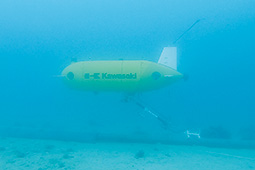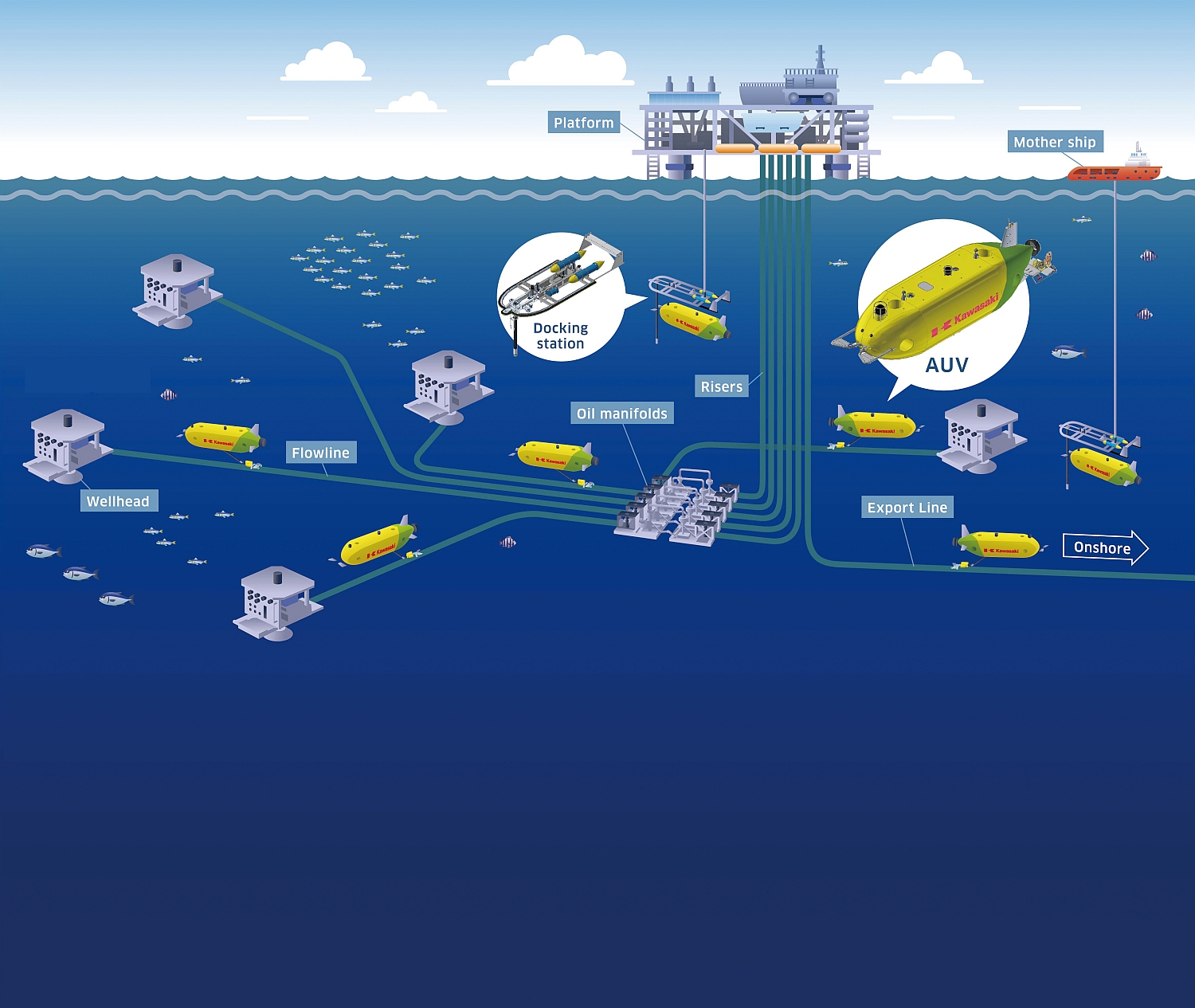
SPICE performing an inspection test using a simulated pipeline in the ocean of Okinawa
November 2021
Underwater Robots for Inspection of Pipelines

An underwater robot has been developed to locate and inspect pipelines for offshore oil fields.

Oceans cover approximately 70 percent of the Earth’s surface and the subsea contains various untapped natural resources. One such resource is oil. After World War II, production of crude oil from offshore oil fields increased with the development of oil fields in the world’s oceans. According to the Offshore Energy Outlook published by the International Energy Agency (IEA) in 2018, crude oil production from offshore oil fields ranged from 26 million to 27 million barrels per day (average from 2000 to 2016), accounting for approximately 30 percent of global crude oil production.
The “vital path” of offshore oil fields are the pipelines laid on the seabed to transport crude oil. There is a danger that pipelines will cause severe marine pollution if damaged, so maintenance and inspection are extremely important. In recent years, however, crude oil has been extracted from the seabed at depths beyond the 300 meter maximum limit of human divers. The challenge was to establish a reliable and efficient method of pipeline inspection at sea depths that are difficult for human divers to reach.
Kawasaki Heavy Industries, Ltd. has risen to this challenge by developing the SPICE (Subsea Precise Inspector with Close Eyes), an autonomous underwater vehicle (AUV) equipped with a robot arm for performing subsea pipeline inspections. Measuring 4.5 meters long, 1.2 meters wide, and 0.9 meters high, SPICE moves freely in the sea like a drone flying on land, autonomously approaching pipelines for inspection using a sonar device that detects objects underwater through sound waves. Moreover, it has the durability to perform inspections in ultra-high pressure environments of 3,000 meters depth.
“The robot arm inspects the external appearance of the pipeline and checks for metal corrosion while maintaining a stable and close distance between the inspection sensor attached to the end of the arm and the pipeline. No other AUV in the world can perform this type of operation,” says Okaya Noriyuki of Energy Solution & Marine Engineering Company, Kawasaki Heavy Industryies, Ltd. “Wireless communication doesn’t work in the ocean, so the entire operation is performed automatically.”
In the past, pipelines at depths that divers are unable to reach were inspected using remotely operated vehicles (ROVs). However, ROVs are operated and powered through a cable from the mother ship at sea, with the reach of the cable limiting the range within which they are able to move and conduct inspections. Cables also affect the motion of ROVs, so they are said to require a very high level of skill to maneuver.
SPICE, on the other hand, does not require a cable connecting it directly to the mother ship, so it can move over a wider area than ROVs. Around 20 kilometers of pipeline can be inspected during a single dive. Also, SPICE averages a speed of two knots during an inspection (one knot is approximately 1.85 kilometers per hour), making it two to four times faster than an ROV.
Another key feature of SPICE is that it can work continuously for long periods because it can be recharged in the sea. SPICE is lowered from the mother ship still attached to its docking station, from where it launches itself automatically to perform operations such as pipeline exploration and inspection. When it needs to recharge, SPICE automatically returns to the docking station, resuming operations once the recharge is complete. It can operate for around eight hours on a single charge.
“SPICE can significantly reduce the time required to inspect pipelines. This can not only reduce the cost of inspections, but also the carbon dioxide emissions associated with the operation of the mother ship,” says Okaya.
Since commencing development of AUVs in 2013, Kawasaki Heavy Industries, Ltd. has been developing and verifying technologies such as automatic docking, underwater battery charging, and pipe tracking using robotic arms. In 2017, the company began to develop SPICE, an AUV that combines these technologies for pipeline inspection, winning its first order for the robot in May 2021 from a British company. In the future, SPICE will be used for inspecting subsea pipelines in the North Sea and other oceans of the world.
“Looking forwards, our intention is that SPICE may also be used for maintenance of offshore wind power generation facilities,” says Okaya.
The day is not far off when Japan’s underwater robot SPICE will be active around the world quietly supporting the world’s energy supply.


